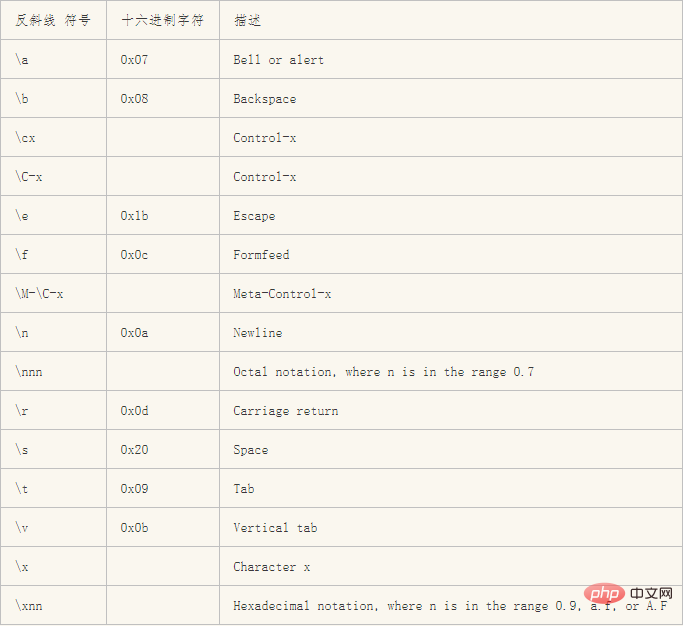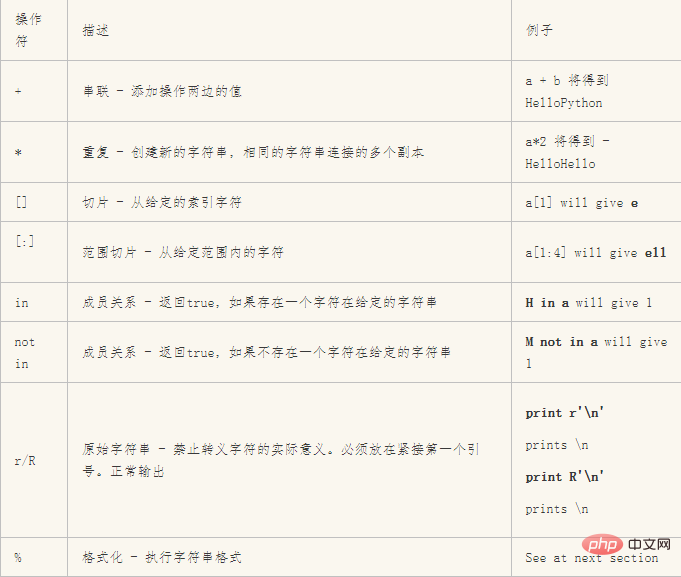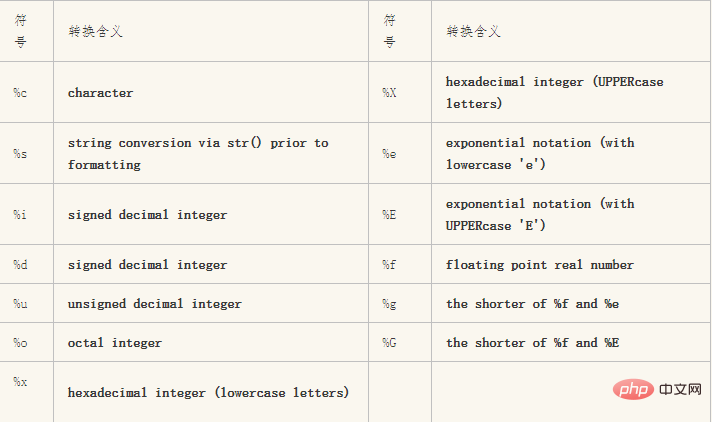What are the python character types?

What are the character types in python? Let me introduce to you the types of character types:
String
Definition: a = 'Python' a = '123' a = "Python" a = """123""" a = '''Python''' There is no difference between single quoting, double quoting and triple quoting for strings. Those with special meanings are not converted. If you need to output the data in quotation marks normally, add r directly in front of it as follows:
print("a\nb") Output: a and b (note: here is Line wrapped)
Print(r"a\nb") Output: a\nb (Note: r means no escaping)
Print('i'm Python') Error report .Reason: The program is considered to be over when it reaches the second '. m will be treated as a variable, but it is not a variable here, so an error is reported. The correct way to write it is as follows:
print("i'm Python") Anything containing letters needs to be quoted. Otherwise, an error will be reported.
Related recommendations: "python video tutorial"
String built-in methods
#定义变量
msg = "i'm YHL"
capitalize() 注解:首字母大写. 如:已经大写还是大写 其他大写变成小写
print (msg.capitalize())
输出:I'm yhl
lower() 注解:将大写字母转成小写
print(msg.lower())
输出:i'm yhl
upper() 注解:将所有小写转成大写
print(msg.upper())
输出:I'M YHL
center(长度,填充的值) 注解:定义长度.让其变量中字符串剧中显示
print (msg.center(20))
输出: i'm YHL :
print (msg.center(20,"*"))
输出:******i'm YHL*******
count("值") 注解:统计某一字符串出现的次数
print (msg.count("Y"))
输出:1
print (msg.count("Y",0,3))
输出:0 PS:从下标开始找. 下标0-3之间找Y出现过几次. 注意:顾头不顾尾.这里是0-3实际是0-2
print (msg.count("Y",0,-1))
输出:0 PS:从下标开始找. 下标0--1之间找Y出现过几次. 注意:此处的-1表示最后
print (msg.count("Y",3))
输出:1 PS:从下标开始找. 下标3之后开始找Y出现过几次.
endswith("值") 注解:判断以什么结尾.真返回True 否则返回Fales
print (msg.endswith("d"))
输出:False PS:意思是以什么结尾.如果是返回True 否则返回False
=====================================================================================================================
#定义变量 PS:变量中的\t表示空格.默认是一个tab键
msg1 = "a\tb"
xpandtabs() 注解:设置空格大小.默认是八个空格.意思就是说括号中不写数字
print(msg1.expandtabs(10))
输出:设置a and b之间的空格大小.
find("值") 注解:查找字符下标或坐标.注意:\t默认占1位.键盘上空格敲1下占1位.敲2下占2位.以此类推.一个tab键就占1位
print(msg1.find("b"))
输出:2 PS:空格也算. 注意:如果找不到会返回-1
print(msg1.find("b",0,8))
输出:2 PS:如果字符串中出现多个只回显第一个的下标.还有就是这样写是规定一个范围
format("值","值") 注解:格式化字符串
print("{0}{1}{0}".format("name","age"))
输出:nameagename ps:{0}-name{1}-age{0}-name 注意:相当于是下标一一对应
print("{name}".format(name="YHL"))
输出:YHL ps:相当于打印变量name对应的值.
print("{}{}{}".format("name","age","YHL"))
输出:nameageYHL ps:前边中括号有几个后台值就必须有几个.否则会报错. 注意括号不能多.值可以多
index("值") 注解:查找索引
print(msg1.index("a"))
输出:1 PS:如果一个变量中出现多个相同的字母.那么也只返回第一个
PS:find 和 index 都是查找下标.
两个的区别在于:
find:是不知道有没有.是去找. 如果有正常返回.如果没有返回-1
index:是知道有.通过已知的去找对应的下标. 如果有正常返回.如果没有直接报错
=====================================================================================================================
#定义变量
msg2 = "a123"
isalnum() 注解:判断变量是否由数字和字母组成.是返回True.否则返回False 纯数字和纯字母都可以.不能是数字和字母之外的
print(msg2.isalnum())
输出:True
isalpha() 注解:是字母返回True 否则返回False. 必须全是字母
print(msg2.isalpha())
输出:False
=====================================================================================================================
#定义变量
msg3 = "10"
isdecilmal() 注解:判断是否是十进制数. 是返回True 否则返回False 注意:只能是数字.
print(msg3.isdecimal())
输出:True PS:如果是10.2则会报错.
isdigit() 注解:判断是不是整型 注意:只能整数.
print(msg3.isdigit())
输出:True
=====================================================================================================================
#定义变量
msg4 = "if"
isidentifier() 注解:判断字符串中是否存在关键字. 是返回True 否则返回False
print(msg4.isidentifier())
输出:True PS:如果是ifa的话就直接返回True 一定要清楚是关键字.(包含)
islower() 注解:判断字符串是否为小写. 是返回True 否则返回False
print(msg4.islower())
输出:True PS:必须全都是小写. 否则返回False
isupper() 注解:判断字符串是否为大写. 是返回True 否则返回False
print(msg4.isupper())
输出:False PS:必须全都是大写. 否则返回False
=====================================================================================================================
#定义变量
msg5 = " "
isspace() 注解:判断是否为空格.是空格返回True 否则返回False. 注意:\t也是空格. tab \n 敲键盘空格一样
print(msg5.isspace())
输出:True PS:不能有其他的.必须全是空格
=====================================================================================================================
#定义变量
msg6 = "Hello Word"
istitle() 注解:判断抬头. 就是首字母是不是大写.是就返回True. 否则返回False.
print(msg6.istitle())
输出:True PS:是单词的首字母.如果单词中还有别的是大写也是False
=====================================================================================================================
#定义变量
msg7 = "Yhl"
ljust(值,"*") 注解:左对齐.
print(msg7.ljust(10,"*"))
输出:Yhl******* PS:左对齐,缺少的部分用*填充.长度是10
print(msg7.ljust(10))
输出:Yhl PS:左对齐,缺少的部分用空格填充.长度是10
ljust(值,"*") 注解:右对齐.
print(msg7.rjust(10,"*"))
输出:*******Yhl PS:右对齐,缺少的部分用*填充.长度是10
print(msg7.rjust(10))
输出: Yhl PS:右对齐,缺少的部分用空格填充.长度是10
=====================================================================================================================
#定义变量
msg8 = " abcd "
strip() 注解:去掉空格(前后都去). 如果:" SA SAS"那么中间的空格无法去除
print(msg8.strip())
输出:abcd
lstrip() 注解:只去掉左边的空格.右边的不去掉
print(msg8.lstrip())
输出:abcd "
rstrip() 注解:只去掉右边的空格.左边的不去掉
print(msg8.rstrip())
输出: abcd
maketrans("值","值") 注解:制作翻译表.下边是用法. 长度必须是一一对应否则会报错.
msg9 = "my name is abcd"
table = str.maketrans("a","2")
print(msg9.translate(table))
输出:my n2me is 2bcd
=====================================================================================================================
#定义变量
msg10 = "abcdefg"
zfill(10) 注解:右对齐.左边不够的用0填充
print(msg10.zfill(10))
输出:000abcdefg
python 字符串相关方法Common string operations
1.移除空白
msg01 = " dsadasi21 \n "
print(msg01.strip())
输出:dsadasi21
2.分割
msg02 = "www.baidu.com"
print(msg02.split("i"))
输出:['www.ba', 'du.com'] PS:以i为点进行分割.
print(msg02.split(".",1))
输出:['www', 'baidu.com'] PS:以.进行分割1次.
print(msg02.split(".",2))
输出:['www', 'baidu', 'com'] PS:以.进行分割2次. 注意:如果.在字符串中不够分的次数.那么不会报错.按最多分
print(msg02.split(".")[0])
输出:www PS:以.进行分割.并打印出下标为0的数据
print(msg02.split(".")[-1])
输出:com PS:以.进行分割.并打印出最后一个数据
print(msg02.split(".")[0:2])
输出:['www', 'baidu'] PS:以.进行分割.并打印出下标是0,1的数据
3.长度
msg03 = "www.baidu.com"
print(len(msg02))
输出:13 PS:计算字符串长度
4.索引(和切片很像)
msg04="welcometobeijingYhl"
print(msg04[2])
输出:l PS:通过索引获取字符串中对应的值
print(msg04.index("o"))
输出:4 PS:通过字符串中的值找对应的下标(索引)
5.切片
msg04="welcometobeijingYhl"
print(msg04[0:3])
输出:wel
print(msg04[0:])
输出:welcometobeijingYhl
print(msg04[0:-1])
输出:welcometobeijingYh
print(msg04[:])
输出:welcometobeijingYhl
print(msg04[2])
输出:l PS:通过索引取对应的值
print(msg04[2:7:2])
输出:loe PS:步长. 各几个取几次. The following table is a list of non-printing characters that can be represented by escape or backslash symbols.
Note: In doublequoted strings, escape characters are interpreted; in singlequoted strings, escape characters are preserved.

String operators
Suppose A holds the string variable 'hello' and variable b holds 'Python':

Evil string splicing:
The string in python is represented as a character array in C language, each When you create a string for the first time, you need to open up a continuous space in the memory, and once you modify the string, you need to open up a new continuous space again. Every time the evil plus sign ( ) appears, it will be re-opened in the memory. Create a new space.
The following is a complete list of the complete set of available symbols:

Other supported symbols and functions are listed in the following table:
The above is the detailed content of What are the python character types?. For more information, please follow other related articles on the PHP Chinese website!

Hot AI Tools

Undresser.AI Undress
AI-powered app for creating realistic nude photos

AI Clothes Remover
Online AI tool for removing clothes from photos.

Undress AI Tool
Undress images for free

Clothoff.io
AI clothes remover

Video Face Swap
Swap faces in any video effortlessly with our completely free AI face swap tool!

Hot Article

Hot Tools

Notepad++7.3.1
Easy-to-use and free code editor

SublimeText3 Chinese version
Chinese version, very easy to use

Zend Studio 13.0.1
Powerful PHP integrated development environment

Dreamweaver CS6
Visual web development tools

SublimeText3 Mac version
God-level code editing software (SublimeText3)

Hot Topics
 1387
1387
 52
52
 Is the vscode extension malicious?
Apr 15, 2025 pm 07:57 PM
Is the vscode extension malicious?
Apr 15, 2025 pm 07:57 PM
VS Code extensions pose malicious risks, such as hiding malicious code, exploiting vulnerabilities, and masturbating as legitimate extensions. Methods to identify malicious extensions include: checking publishers, reading comments, checking code, and installing with caution. Security measures also include: security awareness, good habits, regular updates and antivirus software.
 How to run programs in terminal vscode
Apr 15, 2025 pm 06:42 PM
How to run programs in terminal vscode
Apr 15, 2025 pm 06:42 PM
In VS Code, you can run the program in the terminal through the following steps: Prepare the code and open the integrated terminal to ensure that the code directory is consistent with the terminal working directory. Select the run command according to the programming language (such as Python's python your_file_name.py) to check whether it runs successfully and resolve errors. Use the debugger to improve debugging efficiency.
 Can vs code run in Windows 8
Apr 15, 2025 pm 07:24 PM
Can vs code run in Windows 8
Apr 15, 2025 pm 07:24 PM
VS Code can run on Windows 8, but the experience may not be great. First make sure the system has been updated to the latest patch, then download the VS Code installation package that matches the system architecture and install it as prompted. After installation, be aware that some extensions may be incompatible with Windows 8 and need to look for alternative extensions or use newer Windows systems in a virtual machine. Install the necessary extensions to check whether they work properly. Although VS Code is feasible on Windows 8, it is recommended to upgrade to a newer Windows system for a better development experience and security.
 Can visual studio code be used in python
Apr 15, 2025 pm 08:18 PM
Can visual studio code be used in python
Apr 15, 2025 pm 08:18 PM
VS Code can be used to write Python and provides many features that make it an ideal tool for developing Python applications. It allows users to: install Python extensions to get functions such as code completion, syntax highlighting, and debugging. Use the debugger to track code step by step, find and fix errors. Integrate Git for version control. Use code formatting tools to maintain code consistency. Use the Linting tool to spot potential problems ahead of time.
 Choosing Between PHP and Python: A Guide
Apr 18, 2025 am 12:24 AM
Choosing Between PHP and Python: A Guide
Apr 18, 2025 am 12:24 AM
PHP is suitable for web development and rapid prototyping, and Python is suitable for data science and machine learning. 1.PHP is used for dynamic web development, with simple syntax and suitable for rapid development. 2. Python has concise syntax, is suitable for multiple fields, and has a strong library ecosystem.
 Can vscode be used for mac
Apr 15, 2025 pm 07:36 PM
Can vscode be used for mac
Apr 15, 2025 pm 07:36 PM
VS Code is available on Mac. It has powerful extensions, Git integration, terminal and debugger, and also offers a wealth of setup options. However, for particularly large projects or highly professional development, VS Code may have performance or functional limitations.
 Can vscode run ipynb
Apr 15, 2025 pm 07:30 PM
Can vscode run ipynb
Apr 15, 2025 pm 07:30 PM
The key to running Jupyter Notebook in VS Code is to ensure that the Python environment is properly configured, understand that the code execution order is consistent with the cell order, and be aware of large files or external libraries that may affect performance. The code completion and debugging functions provided by VS Code can greatly improve coding efficiency and reduce errors.
 Golang vs. Python: Concurrency and Multithreading
Apr 17, 2025 am 12:20 AM
Golang vs. Python: Concurrency and Multithreading
Apr 17, 2025 am 12:20 AM
Golang is more suitable for high concurrency tasks, while Python has more advantages in flexibility. 1.Golang efficiently handles concurrency through goroutine and channel. 2. Python relies on threading and asyncio, which is affected by GIL, but provides multiple concurrency methods. The choice should be based on specific needs.





